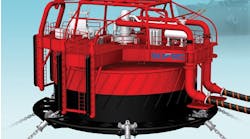Turnkey drilling success leading to completions
The word "turnkey" has often brought with it a look of horror on the faces of service providers and operators worldwide. The idea of compensating on a time and efficiency basis, instead of "service-pricing" (per job) led to some service providers saying the concept will never work. Operators concerned with safety issues shuttered to think that anyone asking for compensation based on time and efficiency would most certainly sacrifice safety, and send incidents, and the inevitable accidents, sky-rocketing.
This sentiment probably subdued the "turn key" craze into the mid-1990s, where a change in thinking occurred. In 1996, a noticeable increase in the number of turnkey drilling bids requested by operators developed. This trend continued through 1998 at about the same rate. The first half of 1999 saw another increase, above the previous trend. More bids were submitted per month in the first half of 1999 than any year to date. Many will argue about the driving force(s) behind this increase, but one of the most likely reasons is the operators' willingness to "outsource" core engineering and operations, functions previously performed by the operator.
A few companies have taken advantage of this new operating environment, and attacked it with the "turnkey" concept. Applied Drilling Technology Inc. (ADTI) alone has drilled 600 wells in the Gulf of Mexico on a turnkey or managed basis.
The reasons for such a large presence in the Gulf of Mexico, according to Douglas Vrooman, ADTI President, were "safety, and using best-in-class service providers." He said that safety had become "our leading selling point," and pointed to a 50% lower lost time accident (LTA) incidence rate than the industry in general for the US offshore. OSHA recordable rates are about 20% lower than the US industry offshore.
The success of ADTI in the drilling phase of well construction and operators' greater tendency to outsource have led into a new phase of turnkey operations - completions.
ADTI recorded a huge increase in the number of completions bids from operators in the first half of 1999. Again, different reasons may be present, but one of the most prominent is most likely shortage of engineering staff in a suppressed market. Anticipated growth has operators scrambling to plan future well projects. This increase creates an opportunity for outsourcing the completions phase of well construction. Companies such as ADTI say they want to engineer and manage completions operations all the way to flow testing of the well. If this shift in the way the industry conducts business continues, expect more activity in the turnkey, alliance, joint venture, and integrated managed project areas.
VSP/gyro/gamma ray single trip data grab in horizontal well
Confirmation of final 3D well trajectory with gyro measurement devices, and collection of wellbore vertical seismic profiling (VSP) data are usually acquired in separate, independent trips in the hole - after the well is drilled to total depth. The reason for two runs has always been that acoustical noise generated by the gyro conflicts with VSP data acquisition.
This means added rig time for separate wireline runs, and if the well profile is highly tortuous, and/or high angle, the possibility of a drill pipe conveyed VSP logging solution comes into consideration. Drill pipe logging operations are very time intensive and costly to complete. Acquiring both types of data in these conditions is difficult at best. The only option is to acquire gyro data on the trip in the hole and the VSP data on the trip out of the hole, where the gyro can be turned off, or placed in an idle state.
CGG recently collaborated with Scientific Drilling (SDC) to develop an alternative method of conveying downhole VSP and directional gyro equipment, simultaneously in highly deviated wells. Surveying companies have always used a "pump-down" method to deliver magnetic and gyro, directional survey tools to the desired location inside the bottom hole assembly during the construction phases of a well. A collaboration between the two companies has succeeded in developing a combination tool which incorporates both the SSR slimline 3C VSP receiver from CGG, and the Keeper gyro/gamma tool from SDC, in the same tool string. A flexible joint between the two subs is installed to allow for proper alignment of the independent tool components in a tortuous wellbore.
A popular drilling practice upon achieving total depth and conditioning the hole is to pull into the nearest casing, service the rig, then trip back to bottom for a final wiper trip of the well. This final wiper trip could include pumping down the combination survey/logging tool - before tripping in, and take pre-determined, timed gyro/gamma measurements on the trip in the hole using standard drillpipe conveyed logging techniques. After reaching bottom, the gyro/gamma tool can be turned off and the VSP logged on the trip out of the hole. Entry of the wireline to the drillpipe can be through a side-entry sub, or the gooseneck.


